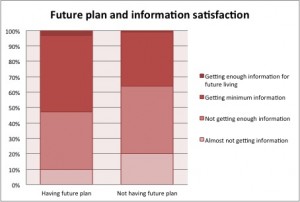“What is reconstruction?” – this is the question that is stuck in my mind. It is 2 years after the earthquake. People in the affected area have been making effort towards reconstruction. The more effort they make, the more this question bothers me. Here, I’d like to reconsider what “reconstruction” is.
There is no clear definition of “reconstruction”. However, generally it is accompanied with a sense of feeling that “things are better than pre-disaster.” Let’s conduct a thought experiment. Draw a graph taking GDP or population on the y-axis and year on the x-axis. Starting from 1945, the curve will look like the one below.
Now, remember Niigata earthquake in 1964. Things were destroyed by this disaster, but we restored these. In this era, Japan’s economy was soaring. Therefore, the restoration automatically meant reconstruction and we were able to feel that “things are better than pre-disaster”.
On the other hand, when Mid-Niigata Earthquake occurred in 2004, Japan was experiencing economic downturn. Therefore, restoring back to what it used to be did not mean reconstruction. We could not feel now is better than the past. Hence, the question “what is reconstruction” is very complicating.
There’s one thing I realized through tackling this question. Maybe we need to measure “reconstruction” using a different axis or index. We cannot “reconstruct” if we rely on the same axis, as it is difficult to create an upward curve. Then, which axis or index should we take? Affluence seems to be a good one. During the period of economic growth, the index was measurable affluence (such as GDP and population). Then, during the economic downturn, what could affluence refer to? I don’t think we have found one yet. In this sense, thinking about the question “what is reconstruction” could mean thinking “what is affluence?”
Here is the advice I received from a senior colleague that I would like to share. “There seems to be more than one index, and each person has different index (or values)”.
Thank you for reading this essay. Sometimes we may need to stop our hands, step back and think flexibly in our heads. From tomorrow again, let us work on the ground with a fresh mind and flexible thoughts. I wish us best of luck.
Tweet





